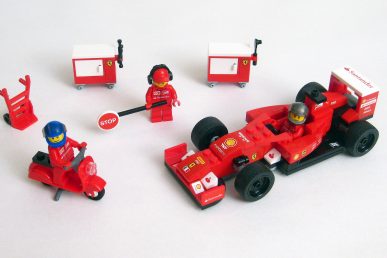If you are running no OpenStack at all and you want to get to the next point where you can test it out to see if the knees work, Eric Wright has a training plan for you. He sees it much like the popular programs that get you off the couch to running a 5K in no time.
With this plan, “there’s no commitment to suddenly become a massive, resilient OpenStack operator. It’s simply about being able to give you a starting point where you can begin your learning journey on OpenStack.” In about in 40 minutes, with zero experience you can launch an entirely functional multi-node OpenStack lab, he says. Wright outlined how to go from “zero to hero” in a recent talk at the OpenStack Summit Austin.
“You are not a zero now and you actually won’t be a hero but at the very minimum it’s about giving yourself the opportunity to test things out without having to shave yaks in order to do it,” he adds.
OpenStack learning challenges
That first jog can often be a humbling one, he says. People interested in learning OpenStack start out going online, interested in learning about networking, say, so they Google it and there’s a lot of material to quickly and easily walks you through step-by-step on how to do networking.

“It’s very simple, two steps. Everybody will tell you, first, you draw a couple of circles then you finish drawing the owl,” Wright says. “But it’s important that you find the right resources to get you from the circles to maybe a bit more detailed circles and add a few steps because if you don’t, you will begin your OpenStack journey and you will be solving mathematically.”
That’s how he describes his first run at installing OpenStack. He trudged through an install line by line, code by code on Ubuntu using the OpenStack documentation about four years ago. “I don’t think I have ever recovered from that…If feels like the finish line but it’s really the start line,” he says. “You’ve gone through a lot of pain to get to the start line. Luckily we’ve got a lot of ways that we can do this more simply because there are distributions out there.”
OpenStack distributions
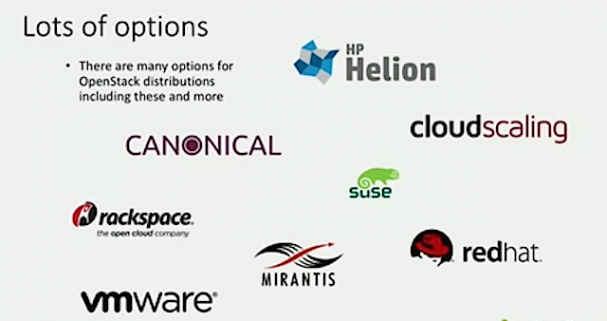

Enter the distribution, a way to fast-track your OpenStack knowledge, Wright says. “The package managers are different. You want to pick the one that you’re comfortable with, that’s what makes more sense…The OpenStack core is identical. It’s just package management that changes it.”
OpenStack Project topologies
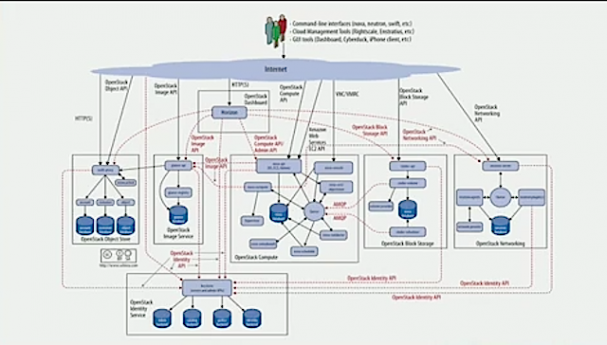
Wright keeps the diagram of the OpenStack projects on his desktop background “as a gentle reminder of how complex it is,” he says. “But it’s okay because you don’t have to do all this stuff. OpenStack does it for you.”
All of the OpenStack projects communicate to each other by the API. It’s a core requirement to deliver an OpenStack project that it has to communicate with other projects via the API. every single OpenStack project very simply plugs into the other one as a loosely coupled environment. “It’s important when we talk about being loosely coupled because by being loosely coupled it ensures that there’s no SDK you’ve latched on to. Even an SDK is close but we can make changes. They don’t necessarily deprecate them cleanly,” he says. “You always have an API that speaks to the other projects together. This makes sure that forward compatibility, backwards compatibility or future proofing some of our stuff.”
There are six core projects and these are important because they are most likely the projects you are going to interact with in the beginning, he says.
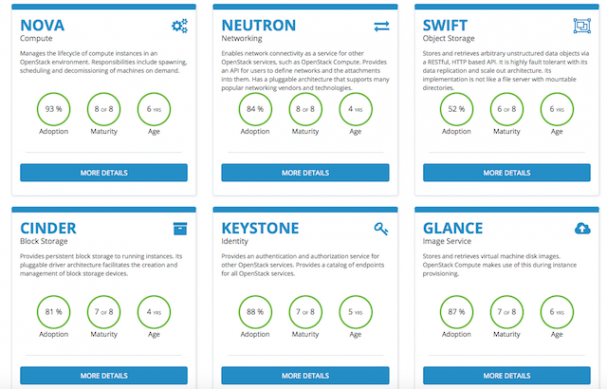
You can further stretch your learning with the OpenStack project navigator. “There’s a ton of great documentation there,” he says. The “number one” thing you’ll want to figure out is Horizon and the dashboard environment.
While it is not considered a core project because it’s not actually required to do anything, he says, OpenStack is built to be consumed by other computers. That’s really what it was meant for. “Horizon is the human side of the dashboard. You can login, you can pull down some content and create environment that’s what that is,” he says. “Go through them and pick and choose which ones you want to dive into. Take a little time and get a sense of what it is because the beauty part is there’s a rich amount of information and it’s freely available.”
Neutron
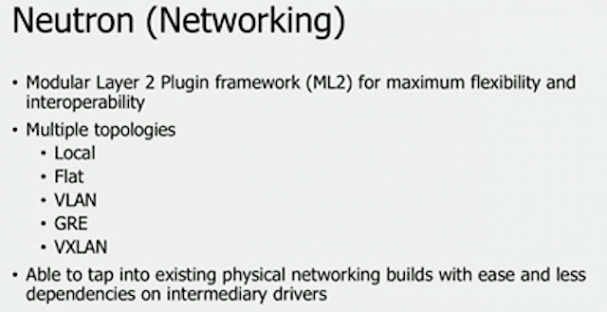
Neutron (networking)
“When you are kicking up the first environment, it’s going to be a local environment. Maybe you have a flat topology. If you are running some kind of an overlay, you can go a little but more advance… “It’s not just at the software tier but at the hardware tier, you are now able to plug in your network environment and you don’t have to necessarily configure. It is just fully available to you,” he said.
“That’s the beauty part. As an OpenStack administrator, we’ve done all the work for you in the community to make sure that you can just communicate with it and you can request networks, request IP addresses. It’s all encapsulated within the OpenStack environment but advanced features can go into your existing topology.”
Nova
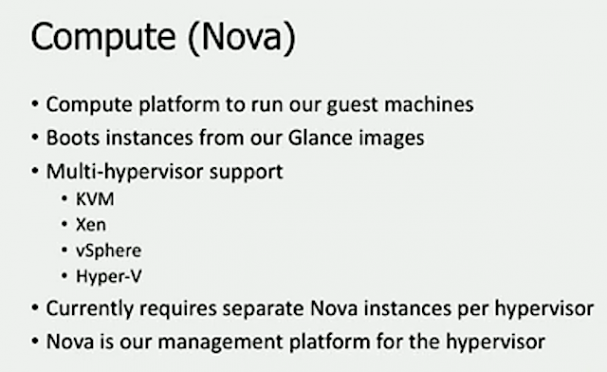
There is no OpenStack without compute. All the compute platform does is wait around our guest instances and boots the instances based on the current block image or an object image and again Nova is not a hypervisor cell so it requires a hypervisor. “When we talk about vanilla OpenStack, it just means that it’s usually Canonical, Ubuntu with a straight OpenStack main trunk code running on top of it,” he says. “They call it vanilla because that’s typically where people start.” Nova is the management tier and that gives you the ability to interact with a hypervisor and do operations like launch an instances. When you look at that environment. All of a sudden you are like, ‘Okay, I can start to see what the different project topologies are and where they make sense,’” Wright says.
Marketplace and the App Catalog
“This came out of the most recent release with Liberty and now with Mitaka, it’s even more cool because what you have is one single webpage where you can go to and you have the opportunity to view all these different apps, different images, different distributions all in one spot,” he says.
This marketplace is a community-contributed environment where you can go through and scan for what you need. “You can find other people who are living the pain you are about to live already for you. They have already done a lot of the early steps to help you along that road. This is all fully and freely available online, and if you want to contribute you just fire it upstream through GitHub.”
OpenStack Cookbook Lab
Wright gave a shout out to the Rackspace crew who have brewed up three editions of the OpenStack Cookbook, and the lab that you can spin up by deploying the code, installing VirtualBox and Vagrant that will launch the environment. It will set up the private network and the management network and it will run the environment for you. You can check out a tutorial for Mac on Wright’s blog.
“It takes about half an hour to actually download and deploy. The reason is because it is pulling down the core image itself, it’s running down a VirtualBox image and then all of the code because it literally builds it live every time you do it,” he says, adding that you wouldn’t want to try this when tethering to your phone to avoid a massive bill.
Online resources
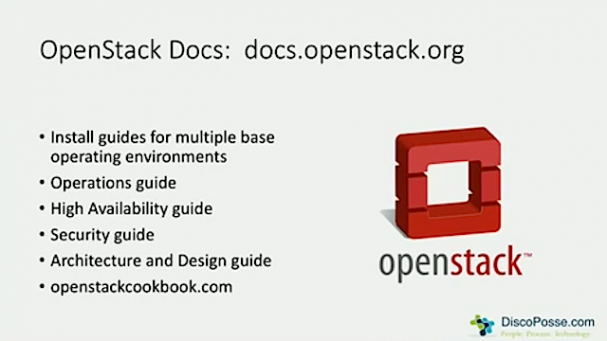
“We are all in this journey together and we all want to succeed together,” Wright says.
Cover Photo // CC BY NC
- OpenStack Homebrew Club: Meet the sausage cloud - July 31, 2019
- Building a virtuous circle with open infrastructure: Inclusive, global, adaptable - July 30, 2019
- Using Istio’s Mixer for network request caching: What’s next - July 22, 2019

)






